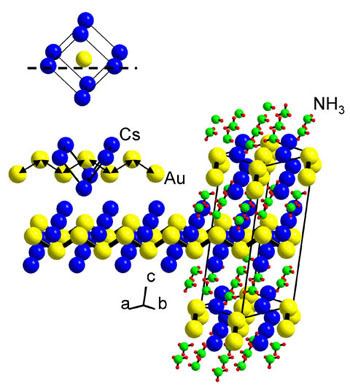Formula CsAu | Appearance Yellow crystals | |
 | ||
Caesium auride (CsAu) is an ionic compound containing the unusual Au− ion first discovered in 1978 in the laboratory of Joseph Lagowski. It is obtained by heating a stoichiometric mixture of caesium and gold; the two metallic-yellow liquids react to give a clear product. The solution in liquid ammonia is brown, and the solid is yellow (the colour of both metals making up the compound); the ammonium adduct is dark blue. Despite being a compound of two metals, CsAu lacks metallic properties since the free electrons in both metals are used up, as in all ionic compounds.
The compound reacts violently with water, yielding caesium hydroxide, metallic gold, and hydrogen gas; in liquid ammonia it can be reacted with a caesium-specific ion exchange resin to produce tetramethylammonium auride.
